
Research
Physics controls on marine ecosystems
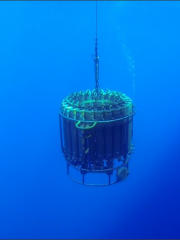


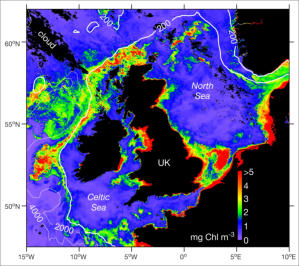
Satellite images all courtesy of the NERC Earth
Observation Data Acquisition and Analysis Service
(NEODAAS).
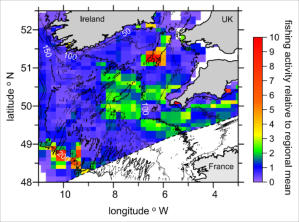
Distribution of fishing activity in the Celtic Sea.
VMS vessel position data for 2008 were analysed
to produce time series of vessel speeds. Fishing
was assumed to be taking place when
vessel speed <4 knots.
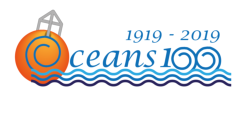
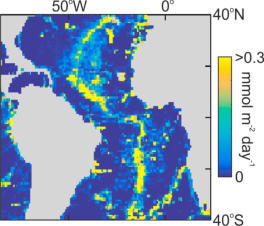
Our predicted flux of nitrate into the
upper ocean caused by internal tidal
waves over the mid-Atlantic ridge.
Top: Deploying an acoustic current
profiler on a mooring during the
CarTRidge expedition in 2025.
Bottom: Deploying an autonomous
glider that carries sensors for
measuring upper ocean properties,
including turbulence.

A: Existing and projected
distribution of offshore wind
generation. The pink areas are the
planned coverage of floating
turbines. Adapted from Dorrell et
al., 2022. B: Scale drawing of a
floating turbine structure alongside
the vertical structure of stratification
and the sub-surface chlorophyll
maximum (SCM).
Top: Satellite-measured sea surface temperature in
the SW approaches to the UK. The shelf edge is
aligned with the 200 metre isobath. The band of cool
water along the shelf edge is caused by mixing by
the internal tide. Bottom: satellite-measured sea
surface chlorophyl in summer. Note the band of
increased chlorophyl (so, surface phytoplankton
concentrations, along the shelf edge. Images
courtesy of NEODAAS PML.
Example vertical profile of temperature,
chlorophyll (as a proxy for phytoplankton) and
nutrients (nitrate) in the Celtic Sea. The peak in
chlorophyll between about 40 and 60 metres is
the sub-surface chlorophyll maximum, and is an
important site of phytoplankton growth through
the summer when the surface water has been
denuded of nutrients.
Main current projects:
CarTRidge
Enhanced carbon export driven by internal tides over the mid-Atlantic
ridge starts from the findings of our Ridgemix research. We think that
the Ridgemix results imply that our current understanding of how the
ocean affects Earth’s climate is missing a significant process: we
underestimate ocean carbon export because we do not include the
effects of internal waves over mid-ocean ridges and seamounts.
Internal waves are generated when tidal currents flow over rough or
sloping seabed. Over the mid-Atlantic ridge we know that these waves
cause turbulence and supply more nutrients upward to the plankton in
the surface ocean. At the same time, the oscillations of the waves
bring the phytoplankton closer to the sea surface, and so increase the
sunlight received for photosynthesis. Increased supplies of light and
nutrient resouces are thought to shift the size structure of the plankton
community to larger species, and larger plankton are better at
exporting particles of carbon to the deep ocean. Bacteria are
constantly recycling dead plankton back to inorganic material,
including changing organic carbon back to inoganic carbon (i.e. CO
2
).
For small particles the recycling to CO
2
can occur near the sea
surface, and so the extra CO
2
can be released back to the
atmosphere. Larger particles sink faster, so they get to the deep ocean
before bacteria can break their organic carbon down to CO
2
. If the CO
2
is produced deeper in the ocean, then the density layers of the ocean
prevent it from being mixed back upward to the sea surface and the
atmosphere: the CO
2
is locked away from the atmosphere for the time
it takes for the ocean’s deep-water to be recirculated back to the
surface, which is several hundred to one thousand years.
We estimate that, averaged over the whole Atlantic Ocean, internal
waves over the mid-Atlantic ridge could be causing about 40% more
carbon export that we currently think happens. Getting this right is
important - we need to have an accurate budget of how carbon is
cycled through the ocean to assess our progress to net-zero carbon
emissions, and we need to understand the ocean processes that
support the carbon export and how those processes might change as
our climate warms.
The CarTRidge project is led by the University of Liverpool, with
collaborators at the University of Southampton, Heriott-Watt University
and the National Oceanography Centre. We ran a major expedition to
the mid-Atlantic ridge in the South Atlantic in early 2025, making
measurements linking from the fundamental physics of ocean
turbulence, up through the growth of the plankton and the make-up of
the plankton community, to the production of sinking particles and the
export of carbon. We are funded by UKRI through the Pushing the
Frontiers grant scheme.
eSWEETS3
Enabling Sustained Wind Energy Expansion in Seasonally Stratified
Shelf Seas is a project funded by UKRI aimed at determining how
floating offshore wind turbines might affect phytoplankton growth in the
thermally-stratifying seas around the UK.
The seasonal thermocline, which separates the warm surface layer
from cooler deeper waters during spring and summer, is a critical
feature in the control of the growth of phytoplankton (see, for instance,
our earlier work on turbulence and phytoplankton). As a result of
controlling phytoplankton growth, the thermocline also plays a role in
the productive shelf sea fisheries and in the ability of shelf seas to
draw down atmospheric CO2.
As offshore wind energy generation pushes out into deeper water, the
turbines can no longer be fixed to the seabed and must instead be
designed as large, floating structures (see image on the right). The
base of these floating turbines reaches down into the thermocline, so
as tidal currents flow past the structures we expect significant extra
turbulence to be generated in the thermocline. This turbulence will mix
nutrients from the deeper water up to the phytoplankton in the
thermocline (and possibly further up into the surface water). Extra
nutrients will drive extra phytoplankton growth - or, that’s our
hypothesis at least.
We will be working with several industry and regulatory partners
towards understanding what the large-scale roll-out of floating offshore
wind turbines will do to the productivity of shelf seas. The work begins
in 2024 using computer simulations to get some initial pictures of the
potential effects of the turbine structures, and we will have a major
ship-based programme of work in summer 2025.
Useful background paper:
Dorrell, R. M., C. J. Lloyd, B. J. Lincoln, T. P. Rippeth, J. R. Taylor, C. P.
Caulfield, J. Sharples, J. A. Polton, B. D. Scannell, D. M. Greaves, R.
A. Hall & J. H. Simpson, 2022. Anthropogenic mixing
in seasonally stratified shelf seas by offshore wind farm infrastructure.
Frontiers in Marine Science, 9,
doi.org/10.3389/fmars.2022.830927.
Other finished research:
Ridgemix
Shelf Sea Biogeochemistry
Turbulence and phytoplankton in the thermocline
Internal tides and the shelf edge ecosystem
From physics to fish over banks in a shelf sea
RidgeMix
The RidgeMix project, funded by the UK Natural Environment
Research Council, was based on the hypothesis that mixing generated
by tidal flows over the mid-Atlantic ridge bring nutrients upward into the
deep chlorophyll maximum (a layer of phytoplankton about 100 metres
below the sea surface).
In September 2015 we deployed a moored array of instruments on the
crest of the ridge to measure mixing and nutrients in the upper 1 km of
the ocean. In summer 2016 we revisited the area on a dedicated
research cruise to make detailed measurements of nutrient supplies
above and away from the ridge, and to recover the moored
instruments.
The first major result to be published was an analysis of the structure
of the internal tidal waves, as seen by the mooring deployed on top of
the mid-Atlantic ridge between September 2015 and July 2016. We
found that about 50% of the internal tide energy went into mode 1
internal tidal wave, with the other 50% in higher modes (modes 2 - 10).
The “mode number” of the wave decsribes how the water movement
associated with the wave is layered through the ocean: mode 1 has 2
layers, mode 2 has 3 layers etc.. The importance of this modal
structure is that it tells us how much energy is available locally for
vertical mixing. The mode 1 wave propagates away from the ridge,
adding low amounts of energy to the abyssal ocean mixing as it travels
across the Atlantic Ocean. The higher modes all contribute to the local
mixing over the ridge; this is what we were looking for, as this mixing
can drive nutrients upward towards the sea surface. These results
from the mooring data are published in Vic et al., 2017.
The second major result was the analysis of our direct observations of
the rate at which nutrients were being mixed upward over the mid-
Atlantic ridge.
Key papers:
Vic, C., A. C. Naveira-Garabato, J. A. M. Green, C. Spingys, A.
Forryan, Z. Zhao & J. Sharples, 2018. The lifecycle of semidiurnal
internal tides over the northern mid-Atlantic ridge. Journal of Physical
Oceanography, DOI:10.1175/JPO-D-17-0121.1.
Tuerena, R. E., R. G. Williams, C. Mahaffey, C. Vic, J. A. M. Green, A.
Naveira-Garabato, A. Forryan, & J. Sharples, 2019. Internal tides drive
nutrient fluxes into the deep chlorophyll maximum over mid-ocean
ridges. Global Biogeochemical Cycles, DOI:10.1029/2019GB006214.
Shelf Sea Biogeochemistry
We were the lead research institute in the pelagic component of the
NERC research programme that aimed to address the role of the shelf
seas in the global cycling of carbon and nutrients. The fieldwork work
took place over 2014-15, with a major programme of 7 research
cruises, working alongside other projects on shelf sea sediments and
on the shelf seas as an iron supply to the global ocean.
Our overall objectives were to:
1. Estimate the size of the shelf carbon pump over the whole NW
European shelf, and its relation to the global carbon cycle.
2. Determine the relative importance of external nutrient sources and
internal biogeochemical cycling in maintaining the shelf carbon pump.
My cruise blog is at: http://jonathanatsea.wordpress.com/
A Special Issue of the journal Progress in Oceanography has been
published, detailing some of the key results of this work (volume 177,
October 2019).
Turbulence and phytoplankton in the
thermocline
In summer in the temperate shelf seas around the UK large areas of
the sea stratify, as solar heating warms up the upper 10 - 30 metres of
water. This stratification plays a vital role in controlling phytoplankton
growth. When the warm layer develops in spring the phytoplankton
held within it grow rapidly (the “spring bloom”), removing nutrients from
the surface waters. The thermocline, separating the warm upper layer
from the colder bottom waters, severely limits the mixing of nutrients to
the phytoplankton so that a lack of nutrients (particularly nitrate) limit
phytoplankton growth in the surface layer during summer.
The thermocline is not a perfect barrier to the mixing of deep water
nutrients up towards the nutrient-starved phytoplankton. There is a
weak turbulent flux of nutrients into the base of the thermocline, where
it is intercepted by a community of phytoplankton that have adapted
their ability to photosynthesise to the low light levels. The plot on the
right shows a water column typical vertical structure from the Celtic
Sea in summer. Note the surface and bottom mixed layers (regions of
homogeneous temperature) separated by a broad thermocline. The
chlorophyll, indicating where the phytoplankton are, is highest in a
broad peak within the thermocline, situated also within the region
where the nutrient concentration (inorganic nitrogen in the form of
nitrate) drops from the high levels in the bottom water to almost zero in
the surface layer. This nitrate gradient, termed the “nitracline”, is where
turbulent mixing can drive a flux of nitrate from the bottom waters into
the phytoplankton layer.
We measure the flux by combining the sample measurements in the
vertical profile with observations of the turbulent diffusivity collected
using a free-fall turbulent microstructure instrument. Typically we will
try to collect profiles continuously over 25 hours, so collecting data
over 2 full tidal cycles, and calculate the daily flux of nitrate to the
phytoplankton. In regions of flat seabed on the shelf we find a vertical
flux of about 1 - 2 mmol m
-2
day
-1
. This is at least a factor of about 10
higher than what is measured in the open ocean, mainly because of
the action of the tidal currents, which are much stronger on the shelf, in
generating turbulence at the base of the thermocline and also
generating vertical oscillations of the thermocline (internal waves)
which also cause turbulence.
We have also shown that the very low levels of turbulent mixing in the
thermocline allows different species of phytoplankton to grow in
different parts of that broad chlorophyll layer. The vertical separation of
species is largely determined by the vertical changes in the spectrum
of light and the ability of different species to utilise different
wavelengths of light in photosynthesis. The low turbulence provides
sufficient time for the different species to grow in the regions where the
light is optimal for them.
Useful papers:
Williams, C., J. Sharples, C. Mahaffey & T. Rippeth, 2013. Wind- driven
nutrient pulses to the subsurface chlorophyll maximum in seasonally
stratified shelf seas. Geophys. Res. Lett., 40, 5467-5472,
doi:110.1002/2013GL058171
Hickman, A.E., P. M. Holligan, C. M. Moore, J. Sharples, V. Krivtsov, M.
R. Palmer. 2009. Distribution and chromatic adaptation of
phytoplankton within a shelf sea thermocline. Limnology and
Oceanography, 54(2), 525-536.
Sharples, J., C. M. Moore, T. P. Rippeth, P. M. Holligan, D. J. Hydes, N.
R. Fisher, & J. H. Simpson. 2001. Phytoplankton distribution and
survival in the thermocline. Limnology and Oceanography, 46(3), 486-
496.
Internal tides and the shelf edge ecosystem
The edges of the continental shelves, where the depth of the ocean
begins to increase rapidly from 100 - 200 metres in the shelf seas to
the abyssal depths of the open ocean, are often found to be sites of
high biological activity. Physical processes associated with the
relatively steeply-sloping seabed can supply nutrients from the deep
ocean to the shelf, and we often find the shelf edge to be targeted by
fishing vessels. A simple link is frequently made between the nutrient
supply enhancing primary production and the environment being
subsequently favourable to fish.
The shelf edge of the Celtic Sea sees large levels of fishing, with
vessels targeting spawning stocks of mackerel, horse mackerel, hake
and whiting. This fishing activity is very tightly focused over the 200
metre depth contour, which marks the shelf edge. A key component of
the physics here is a strong internal tide which, particularly at spring
tides, breaks at the shelf edge and generates considerable turbulent
mixing. This localised area of mixing is often seen in satellite images of
summer sea surface as a band of cool water lying along the 200 metre
isobath. An example is shown on the right, with a band of water at
about 14.5 - 15
o
C at the shelf edge compared to 16.5 - 18
o
C away
from the shelf edge. This cool water has been mixed upward and
brings with it increased concentrations of nutrients (e.g. see Pingree &
Mardell, Phil. Trans. Roy. Soc. Lond., A302, 663-682, 1981). We have
found that this nutrient supply does indeed increase shelf edge primary
production, by about a factor of 2 above that either on the shelf or in
the adjacent NE Atlantic. The effect of this mixing and nutrient supply
of the surface chlorophyll concentration is also clear in satellite
images, with shelf edge chlorophyll being enhanced around much of
the shelf edge to the southwest, west and northwest of the UK and
Ireland (see the second satellite image on the right).
A more intriguing observation that we have made over the shelf edge
is that the species within the phytoplankton community change quite
dramatically in the region influenced by the internal tide mixing.
Phytoplankton cells in the band of chlorophyll along the shelf edge
tend to be much larger than those either on the shelf or off in the NE
Atlantic, with the shelf edge being particularly important for diatoms.
About 60% of shelf edge chlorophyll was made up of phytoplankton >5
microns in diameter, compared to 25 - 30% elsewhere. Rather than the
increased primary production, it is likely that the shift in cell size of the
phytoplankton is key to the existence of the spawning fish stocks. First-
feeding fish larvae are known to ingest phytoplankton, generally
requiring phytoplankton > 5 microns in size.
Useful papers:
Sharples, J., C. M. Moore, A. E. Hickman, P. M. Holligan, J. F.
Tweddle, M. R. Palmer & J. H. Simpson. 2009. Internal tidal mixing as
a control on continental margin ecosystems. Geophys. Res. Lett., 36,
L23603, doi:10.1029/2009GL040683.
Sharples , J., Tweddle, J. F., Green, J. A. M., Palmer, M. R., Kim, Y- N,
Hickman, A. E., Holligan, P. M., Moore, C. M., Rippeth, T. P., Simpson,
J. H., and Krivtsov, V. 2007. Spring-neap modulation of internal tide
mixing and vertical nitrate fluxes at a shelf edge in summer. Limnology
& Oceanography, 52(5), 1735-1747.
From physics to fish over banks in a shelf sea
The distribution of fishing activity in a shelf sea is not uniform.The
figure on the right illustrates which areas of the Celtic Sea are visited
by commercial fishing vessels, based on an analysis of data from the
Vessel Monitoring System (VMS). The most heavily fished region is
over the shelf edge and slope (see Internal Tides and the Shelf Edge
Ecosystem above), followed by a small region (the Celtic Deep) in the
north of the Celtic Sea. In the central Celtic Sea there is a broad region
of moderate fishing activity. During research cruises in 2005 and 2008
we attempted to observe the physics, biogeochemistry and fish
distributions in this region in an attempt to gain some understanding of
why it is attractive for fishing.
The main contrast between this central Celtic Sea region and
elsewhere is that the seabed is marked by several large banks. These
banks are typically 5 - 30 km long, 1 - 10 km wide, and have broad
tops about 50 metres above the surrounding shelf. The surrounding
water depth is 100 - 120 metres, so the banks are not high enough to
reach the seasonal thermocline.
During the cruise in 2008 we carried out work ranging from the physics
of lee waves, mixing and dispersion over the banks, through the
effects on nutrient supplies to the phytplankton, the basic sediment
biogeochemistry over and adjacent to the banks, to the distribution and
behaviour of fish and seabirds. The results are all detailed in a special
issue of Progress in Oceanography.
Briefly, our results show that the action of breaking internal waves
caused by the tidal flow of stratified water over the banks drives very
large fluxes of nitrate into the seasonal thermocline. This nitrate fuels
primary production, but the effects of the nitrate mixing and increased
production are smeared over a broader area because of mean flows
and dispersion away from the banks.
We think it is this increase in biological productivity, driven by mixing at
the banks, that results in the region being favourable for fish and
fishing. We can use bottom mixed layer chlorophyll concentration as a
tracer of water that has recently experienced increased mixing at the
base of the thermocline. The region of increased fishing activity is
bounded by the region of elevated bottom layer chlorophyll
concentrations, indicating the correspondence between water
influenced by mixing and the fishing vessels. For the nitrate-fuelled
increased primary production to be useful to fish, we would expect to
see some correlated pattern in the biomass of the zooplankton. Our
observations of zooplankton over and immediately adjacent to a bank
showed the biomass and species of zooplankton to be similar; this is
what we would expect as a result of the dispersion around the area of
banks. However, overall zooplankton biomass in the region of the
banks was higher than in the non-fished area between the banks and
the shelf edge; this provides the link between the enhanced nitrate-
fuelled primary production and the fish.
Useful papers:
Sharples, J., B. E. Scott & M. E. Inall, 2013. From physics to fishing
over a shelf sea bank. Progress in Oceanography, 117, 1-8.
Sharples, J., J. R. Ellis, G. Nolan & B. E. Scott, 2013. Fishing and the
oceanography of a stratified shelf sea. Progress in Oceanography, 117,
130-139.
Tweddle, J. F., J. Sharples, M. R. Palmer, K. Davidson & S. McNeill,
2013. Enhanced nutrient fluxes at the shelf sea seasonal thermocline
caused by stratified flow over a bank. Progress in Oceanography, 117,
37-47.

























